A Brief History of Corn – From Domestication to 1995
Written by Daniel Brummel, Pioneer Agronomy Systems Manager, and Lance Gibson, Ph.D., Agronomy Training Manager
Written by Daniel Brummel, Pioneer Agronomy Systems Manager, and Lance Gibson, Ph.D., Agronomy Training Manager
Corn (Zea mays), also known as maize, is an essential crop to a rapidly growing world population, with major uses being feed for livestock, fuel ethanol production, and ingredients for hundreds of foods and industrial products. Globally, corn is grown across six of the seven continents, occupying more than 20% of the land devoted to crop production. Total annual corn production is 50% greater than that of wheat or rice and nearly three times greater than soybean. The history of corn is a 9,000-year journey of significant breakthroughs from early domestication to modern advancements that have occurred over the last decade. For a century, Pioneer has played a significant role in producing key innovations to the modern corn crop. This article reviews the history of corn from domestication until 1995, when the current biotechnology era of corn production began.
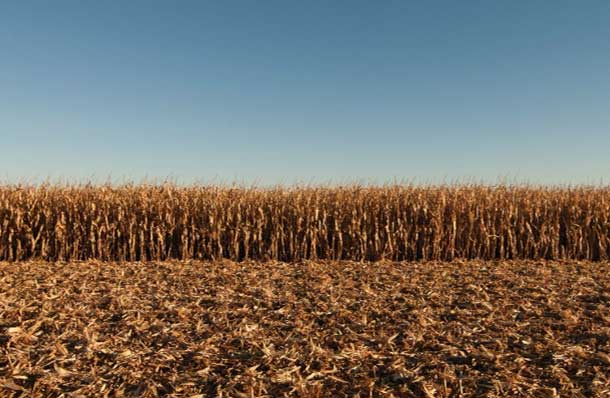
The journey of modern-day corn started around 7000 BCE in southern Mexico with the domestication of a wild grass plant called teosinte (Figure 1). In the early 20th Century, the ancestry of corn was unknown. Research conducted in the early 1930s pointed to teosinte as corn’s wild progenitor, due to similarities in chromosomes and the ability of the two species to produce fertile hybrids. Subsequent research using more advanced genetic tools confirmed this hypothesis. Phylogenetic analysis has placed the timing of genetic divergence between wild teosinte and domesticated corn at around 9,000 years ago. Archeological research in Mexico has shown evidence of corn cultivation dating back at least 8,700 years.
The physical appearance of corn and its ancestor differs considerably. Whereas corn typically has a tall single stalk and produces an ear up to 12 inches in length with hundreds of kernels, teosinte has many short tillers that produce seeds on a thin axis that is 3 inches in length and contains a dozen seeds encased in hard capsules. Despite the significant differences in physical appearance, corn and teosinte are quite similar genetically.
The domestication of corn from teosinte was accomplished by the inhabitants of the area. These ancient corn breeders practiced selective breeding techniques by saving seed from the plants that had desired traits and replanting the seeds for the next harvest season. Dramatic changes in plant appearance were quickly accomplished and what would be considered recognizable corn was widely present across the Americas by 2500 BCE.
When Christopher Columbus arrived on the eastern shores of the Americas in 1492 CE, corn was already being cultivated throughout both North and South America. While essential to the diet of native Americans, the annual acreage of corn in North America around the time of early European settlement was thought to be no more than 50,000 acres (compared to around 110 million acres now.) On Columbus's return voyage to Spain, the explorer brought back corn seed to be cultivated in Europe and Northern Africa. The vast expansion of corn across the globe was extremely swift and like that of no other agricultural crop.
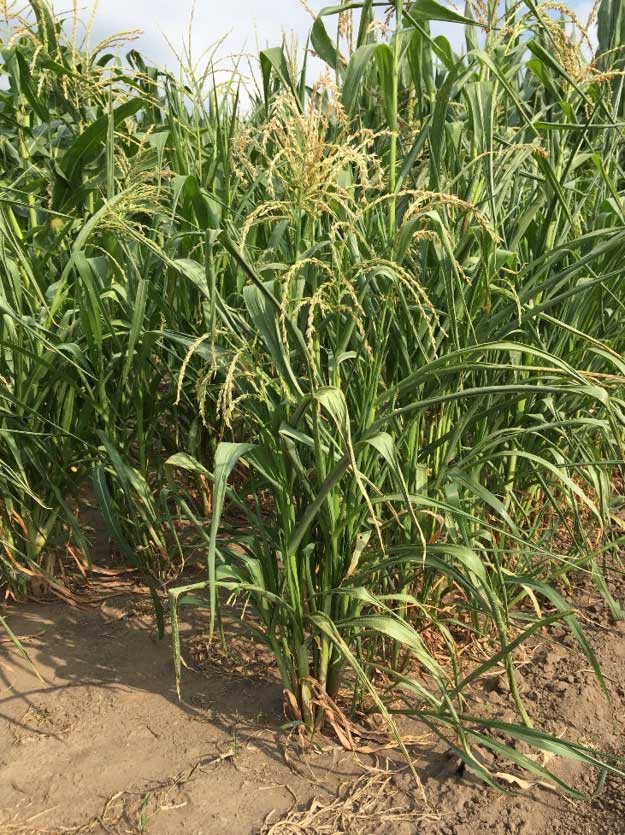
Figure 1. Teosinte (Zea mays subsp. Mexicana), the ancestor of modern corn, native to Mexico and Central America.
The domestication of corn from the tropics to northern temperate areas has shown how adaptable corn can be to various growing environments. Significant modifications have been made by farmers and plant breeders that have made corn a successful agricultural crop around the globe. Different varieties of corn can grow at sea level or at altitudes as high as 12,000 ft; it can reach harvest maturity within as little as six weeks or up to thirteen months.
From its domestication until the 1800s, improvements were made to corn through mass selection and geographical isolation. In mass selection, seed is selected and planted based on visual characteristics of the plant such as size of the ear, plant height or kernel color. These practices resulted in distinct landraces, which are collections of related individuals with enough characteristics in common to permit their recognition as a discrete grouping. Much of this work was done by natives of the Americas as they identified and planted seeds of corn plants that fit their local climate, soil, production practices, and food preferences. Over a hundred distinct landraces of corn have been identified. The various landraces can often be distinguished by ear and kernel characteristics (ear length and width, kernel size and color, hard or soft starch, etc.). The two primary groups of corn when European colonization occurred along the Atlantic Coast of what today is the United States were the northern flints and the southern dents.
With further selection and refinement, varieties with improvements in important traits and reduced variability were developed within landraces. Common varieties of northern flint corn include Longfellow and Tama Flint. These varieties are well adapted to northern climates due to early crop maturity and seedling tolerance to cold soils. Gourdseed, a common variety of southern dent was grown along the southeastern U.S. coastline reaching as far north as Virginia. In the 19th century, farmers discovered that when crossbreeding occurred between the northern flints and southern dents it resulted in superior yielding corn with traits desirable for animal feeding. The combination of northern flints and southern dents resulted in the formation of the Corn Belt dents (Figure 2). The creation of the Corn Belt dents is extremely significant to modern corn production as the bulk of commercial corn varieties worldwide are derived from Corn Belt Dent genetics.
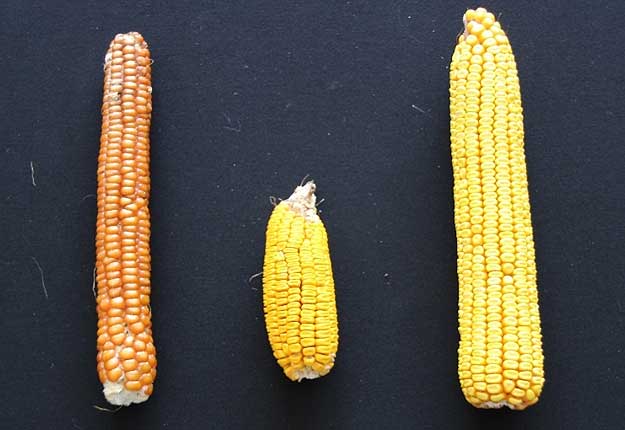
Figure 2. Ears from a northern flint (Longfellow), southern dent (Gourdseed), and Corn Belt dent (Reid Yellow Dent) variety.
New open-pollinated corn varieties can be created by crossing two varieties and saving the seed of the plants that have certain desired traits. (Corn plants have separate male and female flowers, which naturally leads to open, or cross, pollination when wind blows the pollen from one plant to the silks of another.) Farmers continued the practice of crossing varieties of northern flints and southern dents as they settled the Midwestern U.S., developing many Corn Belt open-pollinated varieties. By the early 1900s, it is estimated that around 1,000 different open-pollinated varieties had been created by farmers.
James Reid was a renowned farmer breeder located in central Illinois in the mid-1800s. Reid planted a Gourdseed variety that went through many years of cross breeding with a local northern flint variety known as “Little Yellow Corn.” Careful selection of each generation over many years eventually led to the development of the Reid Yellow Dent corn variety. Reid gave seed to his neighbors to ensure the genetic purity his corn by limiting pollen contamination from other strains of corn. The resulting variety was an overwhelming success, winning corn shows at the Illinois State Fair in 1891 and the World Columbian Exposition in 1893. Reid Yellow Dent became exceedingly popular very quickly, being adapted to nearly every corn producing state and comprising around 75% of all corn acres at its peak. By the early 1900s, hundreds of strains of Reid Yellow Dent had been developed by farmer-breeders.
Even with the use of improved breeding techniques beginning in the mid to late 1800s, average U.S. corn yields remained relatively unchanged, averaging between 20 to 30 bu/acre from 1860 through the 1930s. In the later part of the 19th century and the early 20th century, seed selection by farmers was visually based on the size and consistency of corn ears.
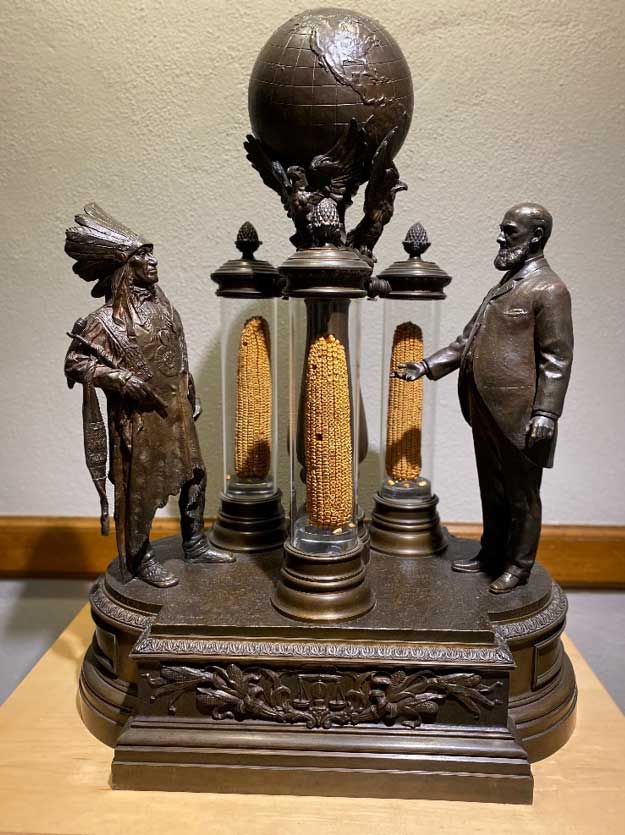
Figure 3. The A.E Cook Corn trophy was commissioned in 1904 to inspire corn development and improvement. The trophy was awarded to the winning collegiate team in the annual corn-judging contest held in Chicago between 1904 and 1907. The trophy is presumed to hold the winning ears from the competition. It displays a Native American chief and an early 20th Century corn breeder. Today, the trophy resides in Curtiss Hall at Iowa State University.
This practice was widely promoted by corn shows, competitive events that were common at the time and reached their peak popularity in the early 1900s. At corn shows, judges awarded large trophies to entries of 10 ears deemed most ‘beautiful’ based on ear and kernel uniformity (Figure 3).
After attending a corn show at the age of sixteen, Henry A. Wallace (who would later found the hybrid seed company that became Pioneer Hi-Bred) walked up to a judge and asked how the judge would know that the blue-ribbon winner, if planted the following year, would produce a higher yield than the ears that did not win a ribbon. Challenging the response of the judge, Wallace began his first corn experiment by planting seed from 25 award winning ears and 25 ears that were marked the poorest at the corn show. After collecting yield data from the three-acre plot located in his backyard, the results showed that the highest yielding corn did not come from an award-winning ear but an ear that was near the bottom of the rankings. In fact, the average yield of the lowest ranking ears was greater than the average of the highest-ranking ears. These results challenged conventional thinking at the time by demonstrating there was no relationship between appearance of the ears and yield.
While the breeding techniques used by farmers were effective at improving easily observed traits, such as plant height, maturity, ear size, and kernel color, they were not suited to improving yield. A lack of pollen control within fields used for seed was also a factor limiting yield improvement. It was the advent of hybrid corn in the early 1900s that put corn on a trajectory of ever-increasing yields that continues today (Figure 4).
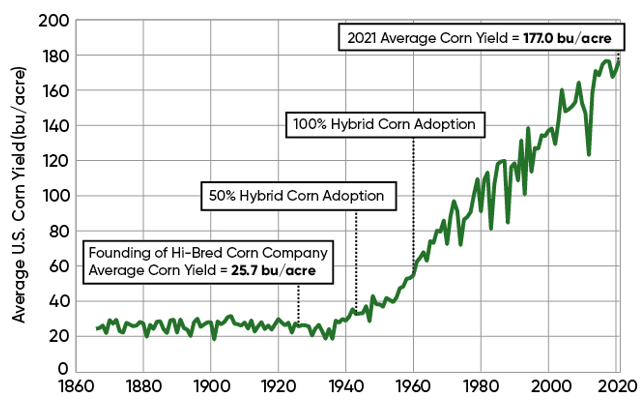
Figure 4. United States average corn yield, 1866-2021 (USDA NASS.)
Scientific research by academics Edward East and George Shull were key to the development of hybrid corn. East and Shull individually initiated research on self-pollinating individual corn plants to produce purified lines – East at Connecticut State College and Shull at Cold Spring Harbor Laboratory in New York. Their pursuits did not turn out as planned as they quickly discovered that just a couple generations of inbreeding resulted in plants with significantly less yield and vigor than the original parent. However, Shull crossed inbred lines he had created and made an interesting discovery – the hybrid offspring had growth superior to the inbred parents and had comparable or better yields and greater uniformity than the varieties from which the inbreds were derived. He published a scientific paper on these results in 1908. Shull had observed the effects of heterosis (also called hybrid vigor) in corn and began immediately applying it in further breeding investigations. In a paper published the next year, he outlined procedures that later became standard in hybrid corn breeding programs (Figure 5).
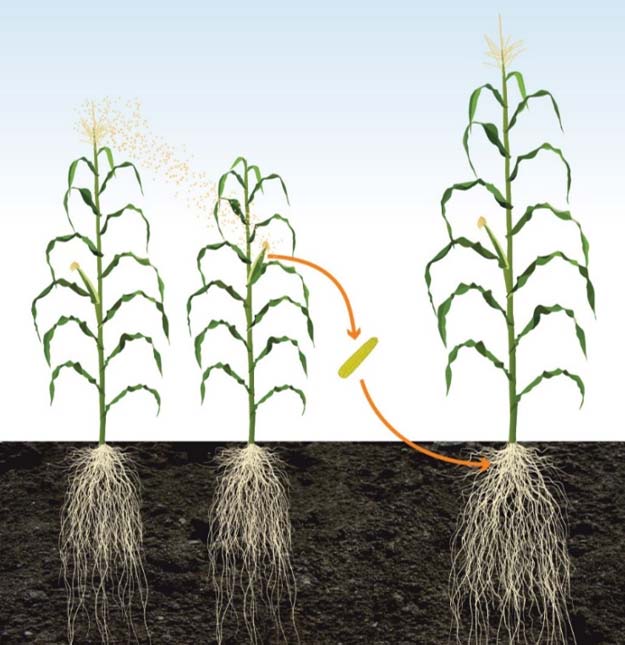
Figure 5. Cross pollination of two corn inbreds to produce a hybrid with agronomic characteristics and yield superior to those of either of the parent lines.
Henry A. Wallace attended Iowa State College, graduating in 1910. While in college, he became fascinated with the relatively new science of genetics. After graduation, Wallace began working on corn-breeding experiments and started breeding hybrid corn in 1920 after visiting Edward East at the Connecticut Agricultural Experiment Station. These early breeding efforts were begun at Johnston, Iowa on 40 acres of farmland purchased with money from the inheritance of Wallace’s wife, Ilo.
The mathematically inclined Wallace taught himself statistics and applied it to his experiments. In 1923, Wallace entered his newest hybrid “Copper Cross” into the Iowa State Yield Test, which it won. The Copper Cross hybrid was created by crossing an inbred created from Leaming corn and an inbred developed from Bloody Butcher corn (Figure 6).
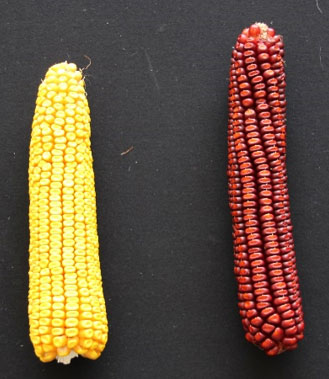
Figure 6. Ears of Leaming (left) and Bloody Butcher (right) varieties, the parent lines of Copper Cross, the first hybrid produced and sold by Henry A. Wallace.
This cross resulted in an ear that had a distinctive copper color. Convinced that hybrid corn had a bright future, Wallace continued to produce and market small quantities of hybrid seed. He also promoted hybrid corn through frequent writings in his family’s magazine, Wallaces’ Farmer, a top agriculture periodical.
The continued success of his hybrids convinced Wallace to expand operations and bring new human and financial resources into the business. With the help of several friends, the Hi-Bred Corn Company was organized and incorporated in Iowa on April 20, 1926. This was the first company devoted solely to the production of hybrid seed and the predecessor of Pioneer Hi-Bred. No person was more important to commercialization and farmer acceptance of hybrid corn than Henry A. Wallace. He was one of a handful of people in the world who initially recognized the immense potential for significant gains in productivity with hybrid corn. Wallace was selected as U.S. Secretary of Agriculture by Franklin D. Roosevelt in 1932 and elected Vice President of the United States in 1940.
Adoption of hybrid corn was slow during the first decade after its commercial introduction in the mid-1920s. By 1935, only around 6% of Iowa corn acreage was planted to hybrids. Farmers were not accustomed to purchasing new seed each year, the seed was expensive to produce, and it was in short supply. The situation began to quickly change in the mid-1930s. Yield tests and farmer experience during the “Dust Bowl” years from 1934 to 1940 demonstrated hybrids to be vastly superior to open-pollinated varieties under severe drought. Once farmers had solid evidence of the benefits of hybrid corn, the transition away from open-pollinated varieties was astonishingly rapid.
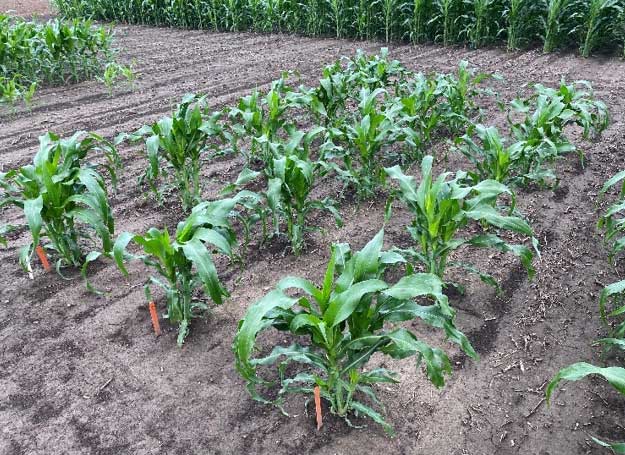
Figure 7. A plot of Pioneer® hybrid 307 in the History of Corn demonstration at the Corteva Agriscience Johnston Global Business Center (June 26, 2020).
In 1936, the Pioneer Hi-Bred company released hybrid 307 (Figure 7). Pioneer 307 was selected based on its strong hybrid vigor and drought tolerance observed on sandy soils. It immediately showed its value in its first year when a catastrophic drought resulted in widespread loss of corn acres in Iowa. Hybrids produced double the yield of open-pollinated varieties under these extreme conditions. Rapid adoption of hybrid corn in Iowa soon followed. Ten percent of acres in Iowa were planted with hybrid corn in 1936; two years later in 1938 it was more than half. By 1942, virtually all corn planted in Iowa was hybrid seed. Within another 20 years, hybrid corn would achieve essentially 100% adoption across all U.S. corn acres. In addition to being more stress tolerant and higher yielding, hybrids were less variable, stood up better, and were easier to harvest than open-pollinated corn varieties.
The significance of hybrid corn adoption was recognized by academics such that it was the basis for the classical model of technology diffusion taught in many economics graduate programs in the 1950s to 1970s. Development of hybrid corn also promoted the advancement of statistics and its establishment as an important field of study. Hybridization of other agricultural crops followed suit, including canola, rice, sorghum, sunflowers, and wheat. Soybean remains an exception because its pollen shed occurs within a closed flower, making outcrossing difficult to achieve on a large enough scale for economical hybrid seed production.
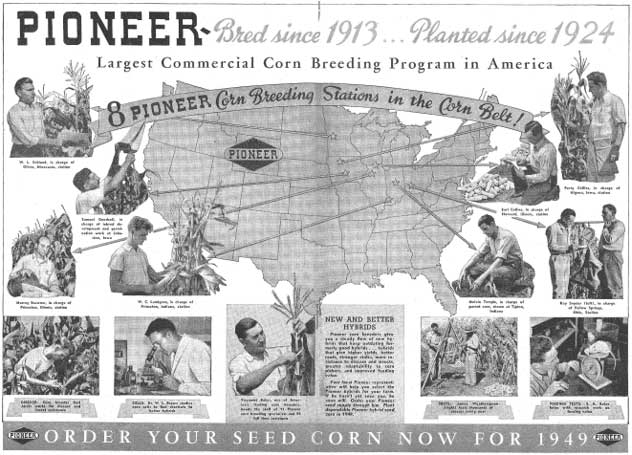
Figure 8. Pioneer advertisement from 1949.
The next significant innovation in corn production was the wide-scale availability of seed for single-cross hybrids. A single cross hybrid results from the controlled crossing of two distinctly different inbred parents. In the early days of hybrid corn, the creation of an inbred required self-pollinating plants for 7 or more generations until they were nearly genetically pure (each successive generation is genetically identical to the previous generation if no outside pollen is introduced.) As documented by Shull, the inbreeding process results in a loss of vigor and seed number per plant. The production of inbred seed was too inefficient when hybrid corn commercialization initially began making the cost of hybrid seed out of reach for most farmers.
The problem of too little seed produced by corn inbreds was overcome using double-cross hybrids. Creation of a double-cross requires successive stages of crossing with two pairs of inbreds. In the first stage, inbreds A and B are crossed to create a single-cross hybrid and inbreds C and D are crossed to produce a second single-cross hybrid. In the second step, the two single-cross hybrids created in step 1 are crossed to produce the double-cross hybrid. Production of a double-cross requires an extra step compared to single-cross hybrids, but results in more saleable seed at a lower cost. While the plants produced from double-cross hybrid seed are not as uniform and high-yielding as those for a single-cross, they exhibited greater vigor and performance than the open-pollinated corn varieties that preceded them.
Double-cross hybrids were primarily grown across the United States from the 1930s through the 1960s. Plant breeders steadily improved the seed production of inbred lines over time to where single-cross corn hybrids became available for purchase by farmers in the 1960s. By the early 1970s, the changeover from double-cross to single-cross corn hybrids was mostly complete. It was shortly after this transition to single-cross hybrids when Pioneer underwent a rapid expansion in the hybrid corn marketplace.
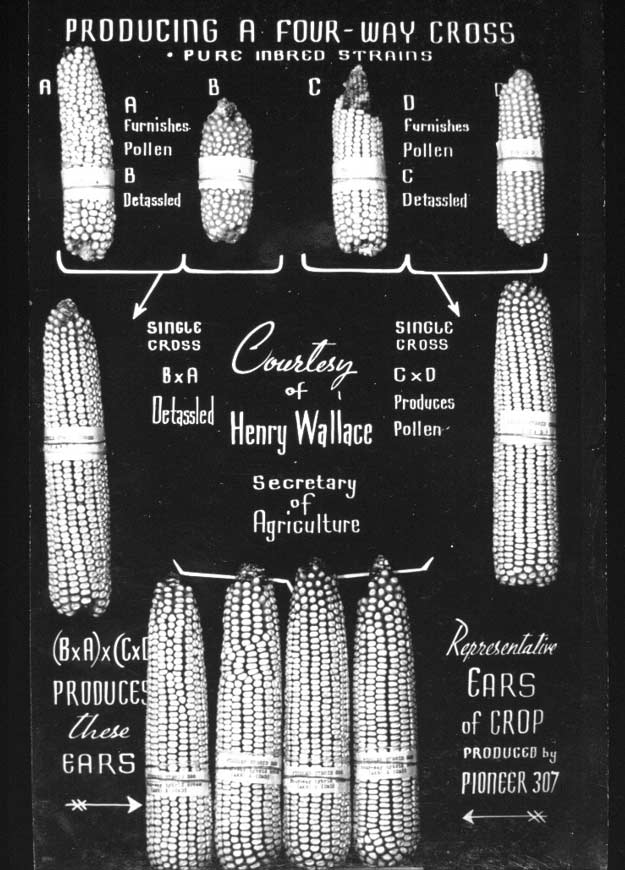
Figure 9. Diagram produced by the U.S. Department of Agriculture showing crosses involved in creating a double-cross, or four-way cross, hybrid.
The structure of the seed corn marketplace during the first five decades after hybrid corn was introduced consisted of four main players: land grant universities, private foundation seed companies, farmer seed companies, and larger commercial seed companies like Pioneer. The private foundation seed companies and the universities focused their efforts on population improvement, inbred line development, inbred seed increase, and hybrid testing. The farmer seed companies produced hybrid seed from university or private foundation inbred lines and sold these hybrids in their local area and sometimes in neighboring counties and states. The larger commercial seed companies developed their own proprietary inbreds and combined them with public lines to create hybrids. They sold seed more widely than farmer seed companies, typically across many states and countries.
Crosses between university-derived inbreds were prevalent in the seed corn industry into the 1970s. The B lines (B17, B37, B73), also known as Iowa Stiff Stalk Synthetics, developed by Iowa State University were of particular importance. A hybrid cross of B73 x Mo17 (an inbred from the University of Missouri), released in 1973, was particularly dominant for several years following its introduction. It was sold by most every Corn Belt seed company, with Pioneer being an exception.
Since its inception, Pioneer took a different approach by heavily investing in its own inbred line development. These efforts paid off greatly in the 1970s, as the strong performance of Pioneer hybrids led to a rapid expansion in corn market share. Much of this rapid growth can be contributed to a breeding project started in 1942 by Raymond Baker (Baker was the second employee hired by Henry A. Wallace in 1928. He spent over four decades managing Pioneer corn breeding programs, retiring in 1971.) Baker obtained seed of “Iodent” corn, a Reid Yellow Dent, from Iowa State University. Through many selection cycles, Pioneer plant breeders optimized the performance of Iodent inbred lines. These lines, as well as other Pioneer-developed inbreds, produced industry-leading corn hybrids that outperformed other popular products like B73 x Mo17.
The unique Pioneer germplasm became a differentiator in the market with the introduction of Pioneer brand hybrids 3780 and 3732 in the 1970s. By the early 1980s, the era of university-derived corn inbreds had passed. Continued investment in breeding superior inbreds allowed Pioneer market share to continue to expand with the introduction of Pioneer brand hybrid 3394 in the early 1990s. This hybrid became so dominant by the mid-90s that, by itself, it outsold the entire hybrid lineups of all competitor seed companies.
Much of this article has focused on genetic improvements to the corn plant since its domestication. However, the history of corn is not complete without a discussion of the adoption of other technologies and agronomic practices by farmers and their contribution to improving corn production. Before the introduction of hybrids, corn was typically planted at a density of 8,000 to 12,000 plants per acre and grown in rows 36 to 42 inches apart. Plant densities above this level would result in smaller ears, plants without harvestable ears, greater root lodging stalk breakage, and dropped ears. Plant breeding has increased the stress tolerance of corn to where it can be planted at much higher plant densities while maintaining a roughly half-pound ear on each plant. Corn is now typically planted at 32,000 to 35,000 plants per acre in higher-yielding environments in rows 30 inches apart, which allows more efficient light capture.
Other important innovations in corn production include synthetic fertilizers, chemical weed control, and mechanization of planting and harvesting. A corn field at the beginning of the hybrid era would typically have been sparsely fertilized with animal manures, mechanically weeded, and harvested by hand. The increased availability of nitrogen fertilizers made most tillable land suitable for corn production and allowed higher-yielding hybrids to reach their full potential. The development of effective herbicides allowed farmers to remove nearly all weeds from corn fields and eliminated the need to use tillage as a weed control tool. Mechanization of corn production has allowed farmers to plant and harvest more quickly as well as gather yields that are nearly seven times greater than when hybrids were introduced.
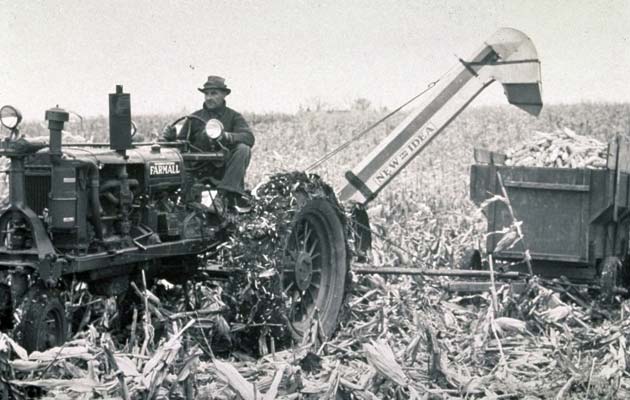
Figure 10. Corn harvest with a tractor-drawn corn picker.
The adoption of hybrid corn combined with improved breeding techniques and agronomic practices resulted in a steady increase of the average U.S. yield from around 26 bushels per acre before the 1930s to 125 bushels per acre in 1995. This rate of gain continued in subsequent years with the introduction of several key technologies, including insect and herbicide resistance traits as well as molecular-assisted breeding, adding another 2 bushels per acre per year since 1995. There is little evidence to suggest the rate of gain for corn yield will level off anytime soon.
After 9,000 years of human manipulation to domesticate, adapt, and develop, corn has become essential to the success of humankind. After becoming U.S. Secretary of Agriculture, Henry A. Wallace, founder of Pioneer, said “Of all the annual crops, corn is one of the most efficient in transforming sun energy, soil fertility, and man labor into a maximum of food suitable for animals and human beings. It is to be regretted that so few of the millions whose prosperity rests on the corn plant should have so little appreciation or knowledge of it....” As authors of this article, we hope you have gained a deeper appreciation of where corn originated and how it came to be of such high importance to feeding, fueling, and sustaining modern civilization. Since its founding in 1926, Pioneer has been a leader in making corn into the powerhouse crop that it is today.
The foregoing is provided for informational use only. Please contact your Pioneer sales professional for information and suggestions specific to your operation. Product performance is variable and depends on many factors such as moisture and heat stress, soil type, management practices and environmental stress as well as disease and pest pressures. Individual results may vary.
Pioneer® brand products are provided subject to the terms and conditions of purchase which are part of the labeling and purchase documents.